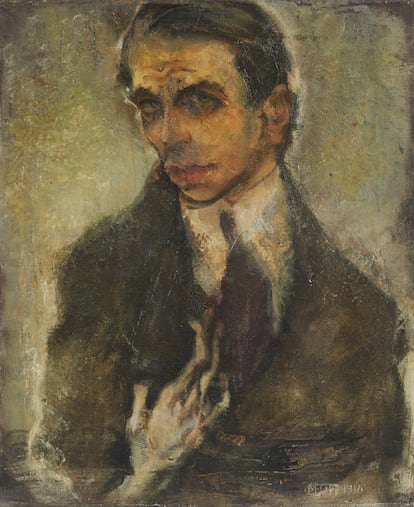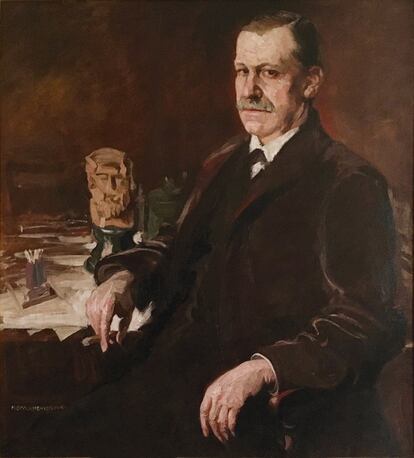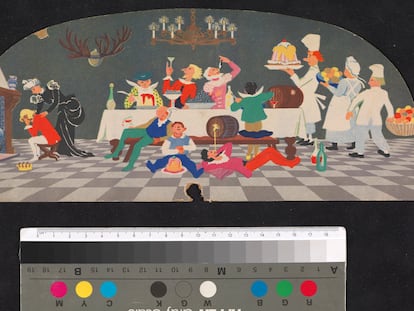Max Oppenheimer: The artist’s role as a pioneer of Expressionism did not lead to success
Vienna’s Leopold Museum rescues the avant-garde painter from oblivion with the largest retrospective devoted to the artist to date

Artist Max Oppenheimer was a key role model for Egon Schiele, while for Oskar Kokoschka he was an enemy to be defeated. He painted portraits of Dr. Sigmund Freud, architect Adolf Loos, composer Ferruccio Busoni, and the writers Thomas Mann, Arthur Schnitzler and Peter Altenberg with a radical brush in a style that would later be known as expressionist. He experimented with cubism and futurism; he starred in exhibitions in Berlin, Munich, Paris, Zurich and Vienna; he created nihilistic art for the revolutionary Cabaret Voltaire in Zurich and degenerate art according to Nazism. He died in exile — in obscurity and poverty — in a New York apartment. And that oblivion has continued until now.
In his hometown of Vienna, the Leopold Museum is now presenting a dazzling retrospective, Max Oppenheimer: Expressionist Pioneer, through February 25, 2024. The exhibit has brought together nearly 200 of the artist’s works. That was not an easy task, given Oppenheimer’s Central European nomadism, the Nazis’ destructiveness and the chaos of two world wars. The exhibit’s main room displays the portraits that forged the Expressionist movement at the turn of the 20th century, and the show immediately leads into Oppenheimer’s high-profile feud with Kokoschka. Although the concept seems novel, the “cancel culture” phenomenon goes back a long way. Kokoschka accused his colleague of plagiarism and encouraged his peers to boycott Oppenheimer’s work. Among the former’s friends were two of the German language’s most creative and incendiary figures, the satirist Karl Kraus and the choleric poet Else Lasker-Schuler, popular for her fits of rage, who embarked on an unprecedented campaign of harassment and destruction to demonize Oppenheimer. Writer Heinrich Mann came to his defense, but the sentence “Oppenheimer copies Kokoschka” went viral in the innovative avant-garde milieu.

Moreover, all that was happening at a time when being a lavish patron was a matter of honor for wealthy industrialists. Among their maneuvers, the intimate cenacle of OK — as signed his name — unsuccessfully tried to cancel the MOPP exhibition at the Paul Cassirer art salon, his official debut before the Berlin public, as did Oppenheimer. “It was very unfair and, in my opinion, provoked by Kokoschka’s jealousy,” says Hans-Peter Wipplinger, the curator of the retrospective and director of the Leopold Museum. “Kokoschka could not tolerate another god of painting overshadowing him and mobilized his closed circle to denounce [Oppenheimer]. It should be remembered that Oppenheimer was a famous personality in the 1910s.″
The poster Oppenheimer created for his first solo exhibition at the prestigious Thannhauser Gallery in Munich in 1911 and the one made by his former friend a year earlier for the Berlin magazine Der Sturm, an icon of the emergence of expressionism, now share a wall at the Leopold Museum.
The next room celebrates the friendship between Schiele and Oppenheimer. The Leopold Museum is intimately linked to the former figure (a passion shared with the Albertina and the Belvedere). It has a collection of 43 paintings and over 200 watercolors, drawings and prints, making it the most important collection in the world. The two artists shared an atelier in Vienna, portrayed each other, challenged the concrete sexual conventions of the time, and looked to French poet Arthur Rimbaud as their role model. Oppenheimer’s influence was crucial in Schiele’s decision to abandon Klimt and develop his own distinctive expressiveness.

One of the exhibit’s star pieces is a 1911 self-portrait of Oppenheimer that, for decades, was thought to be lost, and it is now on public display for the first time in 110 years. The museum acquired it in August, after negotiating an agreement with a private collector and the rightful heirs of Oskar Reichel, a Jewish doctor and art dealer who, after the Anschluss, the annexation of Austria to the Third Reich in 1938, was persecuted by the Nazis and died in Vienna in 1943. It is difficult not to relate the drawing of the broken hand on the canvas to Schiele.
As the wider world was crumbling around him in the Great War, Oppenheimer, an anarcho-pacifist dand y— ”an eternal outsider who longed for sociability,” as Wipplinger put it — took refuge in Switzerland and entertained himself by founding Dadaism with artists of different nationalities. In Zurich, he actively participated in Cabaret Voltaire’s nihilistic program.
On several occasions, he settled in Berlin in pursuit of greater tolerance for his homosexuality and of the artistic hotbed that had taken over from Vienna as the cultural capital of the roaring 1920s. Oppenheimer frequented the bohemian headquarters in the Charlottenburg district, the Romanisches Café (known as the Olympus of useless arts), and experimented with the “new objectivity” when the movement didn’t have a name yet and which Joseph Roth defined as “the commercialization of the joy of living.” The paintings The Orchestra and Six-Day Race are emblematic of this period.
When the Nazis seized power, Oppenheimer’s days in Berlin were numbered: he was of Jewish descent and would soon be labeled a degenerate artist. The exhibition displays an anonymous black-and-white photograph of his 1926 portrait of former mayor Gustav Böss, hung in the window of an SA (Nazi Party storm troopers) tavern to defame him. The photo is next to the original canvas.

Oppenheimer returned to Vienna, but the Anschluss forced him to flee again, first to Switzerland and then to the United States. He left his best works in Austria, not knowing if he would ever be able to get them back. On June 20, 1938, he wrote to his gallery owner: “All my drawings, about 100 sheets, all the graphic work and everything I left in my apartment was stolen, that is, looted.”
Exile, apathy and oblivion awaited him. “It was necessary to correct the art historiography with a large-scale retrospective,” Wipplinger says. He adds that “in the triumvirate of Austrian Expressionism, Egon Schiele and Oskar Kokoschka always occupy the center and, incomprehensibly, Oppenheimer appears in a corner. Even in the art scene, they are unaware of his pioneering role in the development of psychological portraiture and the landscape of the soul. In light of Oppenheimer’s successful career and innovative methods, it is surprising that his work not only went unrecognized over the past few decades, but virtually faded into oblivion.”
Oppenheimer died in 1954. It took three days to find his lifeless body in his New York home.
Sign up for our weekly newsletter to get more English-language news coverage from EL PAÍS USA Edition
Tu suscripción se está usando en otro dispositivo
¿Quieres añadir otro usuario a tu suscripción?
Si continúas leyendo en este dispositivo, no se podrá leer en el otro.
FlechaTu suscripción se está usando en otro dispositivo y solo puedes acceder a EL PAÍS desde un dispositivo a la vez.
Si quieres compartir tu cuenta, cambia tu suscripción a la modalidad Premium, así podrás añadir otro usuario. Cada uno accederá con su propia cuenta de email, lo que os permitirá personalizar vuestra experiencia en EL PAÍS.
¿Tienes una suscripción de empresa? Accede aquí para contratar más cuentas.
En el caso de no saber quién está usando tu cuenta, te recomendamos cambiar tu contraseña aquí.
Si decides continuar compartiendo tu cuenta, este mensaje se mostrará en tu dispositivo y en el de la otra persona que está usando tu cuenta de forma indefinida, afectando a tu experiencia de lectura. Puedes consultar aquí los términos y condiciones de la suscripción digital.
More information
Archived In
Últimas noticias
Most viewed
- Sinaloa Cartel war is taking its toll on Los Chapitos
- Oona Chaplin: ‘I told James Cameron that I was living in a treehouse and starting a permaculture project with a friend’
- Reinhard Genzel, Nobel laureate in physics: ‘One-minute videos will never give you the truth’
- Why the price of coffee has skyrocketed: from Brazilian plantations to specialty coffee houses
- Silver prices are going crazy: This is what’s fueling the rally










































